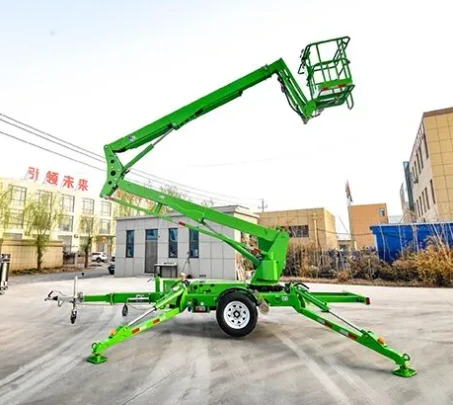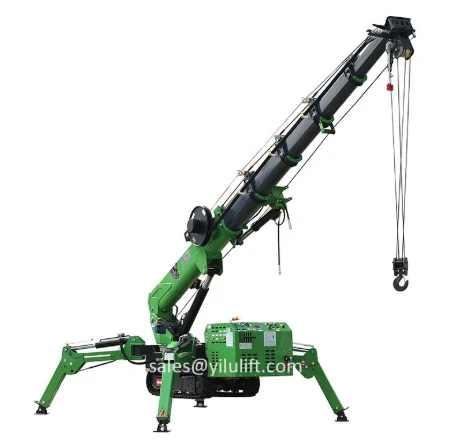Best Lifting Capacities Boom Lifts Versus Heavy-Duty Cranes
Best Lifting Capacities Boom Lifts Versus Heavy-Duty Cranes
Best Lifting Capacities Boom Lifts Versus Heavy-Duty Cranes
In the world of heavy lifting, folks often get stuck choosing between boom lifts and heavy-duty cranes. Both get the job done, but in different ways. At YILU LIFT, we’ve been building these machines out of Qingdao for years, shipping them to over 100 countries like the US, Russia, and Australia. Our gear focuses on tough builds, easy handling, and real-world smarts – think spider cranes that squeeze into tight spots or crawler booms that tackle rough ground.
This post breaks it down, comparing capacities while spotlighting what we offer to help you pick right.

What Are Boom Lifts and How Do They Work?
Auslegeraufzüge, sometimes called cherry pickers, let workers reach high spots safely with a platform at the end of an extendable arm. They run on hydraulics or batteries, moving up, out, and around obstacles. Great for jobs like fixing lights or painting walls. YILU LIFT makes models that blend power and ease, suited for construction sites or warehouses.
These machines shine when you need quick access without a big setup. But let’s dig into the types we build.
Telescopic Booms for Long Reaches
Straight arms that stretch far. Our crawler boom lifts push to 20 meters high with 300kg loads, ideal for straight-up tasks on uneven dirt.
Articulated Booms for Obstacle Navigation
These bend like knuckles to dodge barriers. YILU’s towable articulated versions hit 15 meters, carrying 250kg, perfect for indoor spots with pipes or beams in the way.
Hybrid Power Systems for All Terrains
Mix battery and diesel for quiet runs or tough pulls. Our hybrids switch modes, handling city noise rules or remote sites without a hitch.
Boom lifts keep things moving fast in cramped areas. A crew can roll up, extend the arm, and start work in minutes. That’s handy for maintenance gigs. Now, shift gears to cranes, which bring a different kind of muscle.
What Makes Heavy-Duty Cranes Stand Out?
Heavy-duty cranes hoist big loads with hooks and cables, built for raw strength on job sites. They’re stable beasts for moving steel or concrete. At YILU, our spider cranes pack that power into compact frames, folding small for urban hauls but lifting serious weight.
Cranes step up when booms fall short on heft. They demand more space to set up, sure, but pay off in brute force. Check out the features that set ours apart.
High-Capacity Hoists for Heavy Materials
Lift up to 3 tons no sweat. YILU’s 1.5-ton spider crane grabs 6-meter reaches, spot-on for bulky stuff like beams.

Compact Spider Designs for Narrow Access
Legs fold tight like a spider. Our units slip through doors, then spread for 6.5-meter lifts, a boon in city builds.
Remote Controls for Safe Operation
Run it from afar with winches at 8m/min. YILU adds overload guards, keeping folks clear of swings.
With cranes, you get that solid lift for the heavy end of things. But it’s not always about power alone; sometimes reach wins. Next up, how their lifting specs stack up.
How Do Lifting Capacities Compare Between Them?
Capacity means weight at height – booms go tall with lighter stuff, cranes stay low but haul more. YILU designs overlap, like spider booms that mix both worlds, giving options without swapping machines.
Picking depends on the job’s demands. A tall sign install? Boom. Ground-level machinery move? Crane. Let’s break the numbers.
Height-Focused Capacities in Boom Lifts
Soar 20+ meters with 200-500kg. YILU telescopics nail elevation for tasks like tree trimming or roof checks.
Weight-Driven Strengths in Cranes
Tackle 1-5 tons closer down, up to 6.5 meters. Our spiders shine moving engines or pallets where height ain’t key.
Hybrid Models for Combined Needs
Blend ’em for 300-1000kg versatility. YILU’s crawler spiders handle mixed loads, saving time on varied sites.
Side-by-side, it’s clear: booms for sky work, cranes for ground pound. We hear from clients in Brazil or Germany who mix our lineup for full coverage. But when does one edge out the other?
When Should You Pick a Boom Lift Over a Crane?
Grab a boom when the work’s light and lofty. They’re quicker to deploy, cheaper to run day-to-day. YILU pushes these for spots where speed and access trump sheer strength.
Booms cut setup hassles, letting teams jump in fast. Ideal for short stints or tight budgets. Here’s why they often win.
Worker Access at Heights
Hoist crews safely up. Our crawler booms set quick, stable platforms for wiring or installs.
Maneuverability in Confined Spaces
Weave through halls easy. YILU articulateds bend around gear, nailing indoor fixes.
Cost-Effective Daily Rentals
Save bucks on short jobs. Our models rent cheap, fitting small outfits without big buys.
Yeah, booms keep it simple. But flip it – when loads get massive, cranes take over. Knowing the switch saves headaches.
When Is a Heavy-Duty Crane the Better Option?
Cranes rule for serious heft and steady holds. They need room to spread legs, but deliver where booms wobble. YILU’s spiders fill gaps, compact yet mighty for modern builds.
For long hauls or rough spots, cranes hold firm. They might take longer to rig, but handle the grind. See the scenarios.
Massive Load Management
Sling 3 tons smooth. YILU’s handle steel or blocks, no strain.
Stability on Uneven Ground
Grip dirt with outriggers. Our spiders tackle yards, staying level.
Durability for Extended Use
Run all day with tough winches. YILU builds for repeats, less downtime.
Safety’s non-negotiable with either. Cranes bring power, but both need solid guards. Let’s talk features that keep everyone safe.
What Safety Features Matter Most in These Machines?
No matter the machine, safety stops mishaps. Think overload alerts or stable bases. YILU packs extras like auto-levels, cutting risks on busy sites.
Good gear protects workers and loads. From alarms to backups, it’s about smart design. Key ones we build in.
Overload Sensors and Alarms
Buzz if too heavy. YILU sensors halt on all, dodging tips.
Emergency Descent Mechanisms
Drop safe if power cuts. Our manual overrides get folks down quick.
Outrigger Stability Controls
Lock balance on hills. YILU spiders extend legs firm, no wobbles.
With safety sorted, upkeep keeps ’em running strong. Skip it, and small issues grow big. Simple habits go far.
How Can You Maintain Them for Peak Performance?
Regular checks beat breakdowns. Wipe, lube, inspect – YILU sends guides with each unit, making it straightforward.
Maintenance ain’t rocket science, but consistent. Catch wear early, save cash later. Our tips for top shape.
Daily Inspections and Cleaning
Eye joints, cables, fluids. YILU calls for monthly grease to fend off rust.
Power System Upkeep
Charge batteries, swap filters. Hybrids need clean runs for longevity.
Annual Professional Servicing
Pro tweaks extend life. YILU teams handle deep fixes, keeping warranties intact.
FAQs
Q1: What’s the key difference in lifting between boom lifts and heavy-duty cranes?
A: Boom lifts hit heights with lighter loads, say 200-500kg up 20 meters, while cranes manage tons like 1-5 at lower reaches around 6.5 meters.
Q2: How do YILU’s spider cranes fit tight job sites?
A: They fold small to pass doors, then lift 3 tons strong – perfect for city or indoor work where space pinches.
Q3: Can YILU boom lifts handle rough outdoor spots?
A: Sure, our crawler models grab uneven ground, reaching 20 meters stable for tasks like power line fixes.




